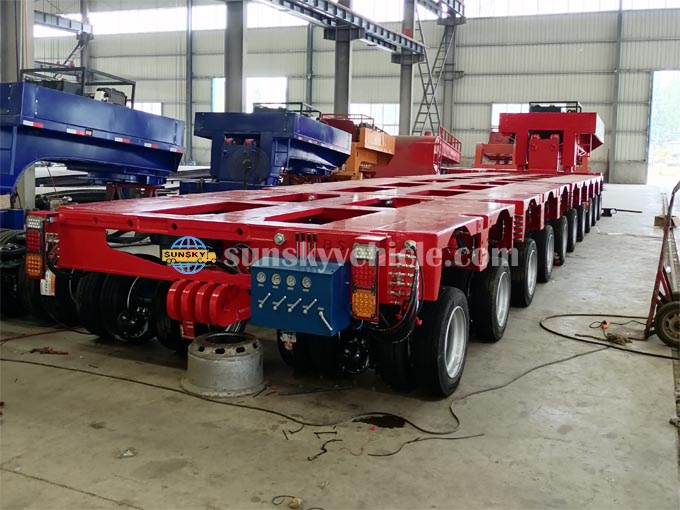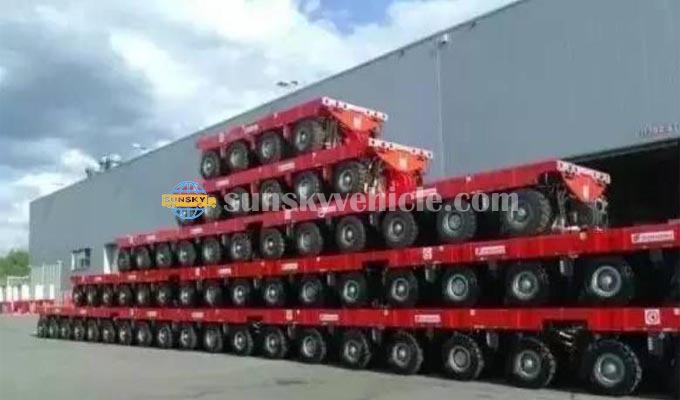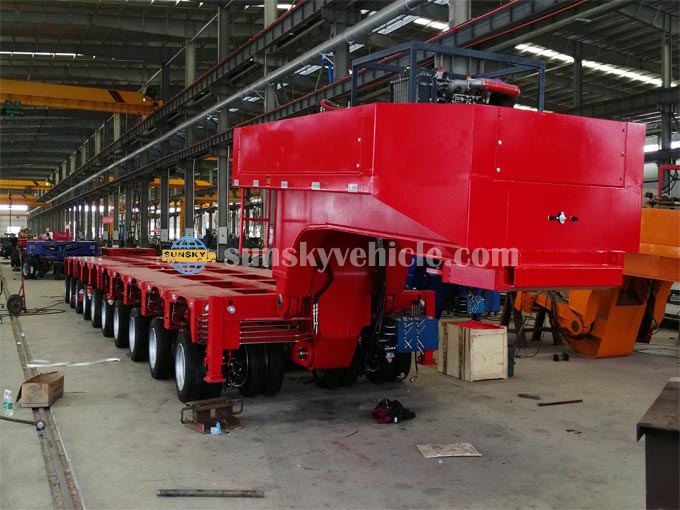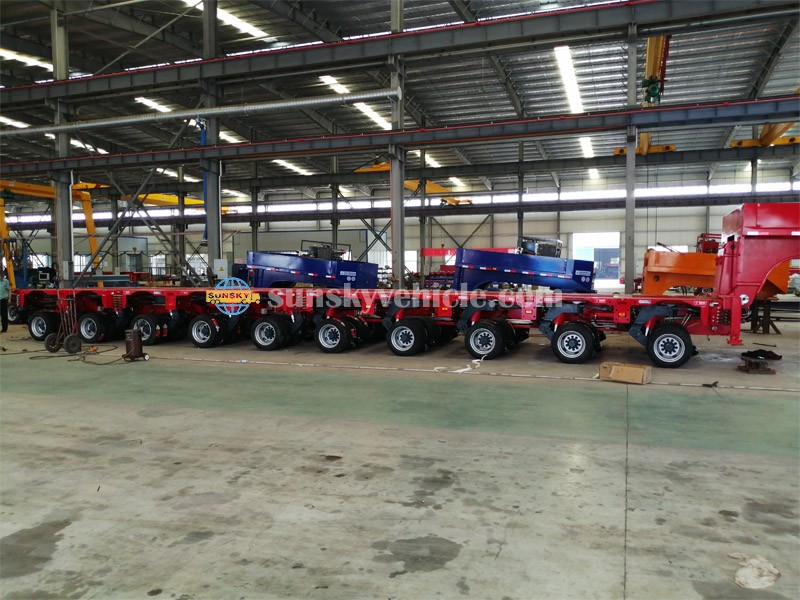Multi Axles Hydraulic Modular trailer
Self-Propelled Modular Transporter(SPMT) is commonly known as the hydraulic module trailer,it is a kind of high-end modular heavy-duty carrier, and the most powerful carrier on land at present.
The Self-Modular Transporter is an array of high-pressure tires and hydraulic cylinders that can be coupled on demand to suit any task. It can be used to transport large goods that cannot be carried by ordinary trucks, such as large reactors, transformers, steel structures, heavy modules, and even buildings.
How did the SPMT develop?
The first self-propelled modular trailer was built in the 1970s. In the early 1980s, Mammoet, a heavy-duty transportation company, refined the concept into the form we see today. They set the width of the modules to 2.44 meters, so the modules can be placed on an ISO container Flatrack. They also added 360° steering. They commissioned Scheuerle to develop and build the first installations. Deliveries began in 1983. The two companies decided on the standard installation: a 4-axis SPMT, a 6-axis SPMT and a power unit. Over the years, more modules have been added to the system to accommodate a range of payloads.

In 2016, the European Association for Excess Load Transport and Mobile Cranes (ESTA) published the first SPMT best practice guidance to help solve the problem of trailer overturn, although operating rules and stability calculations have been followed precisely in some cases.
Some shipbuilding companies have started to use SPMT instead of gantry cranes to transport ship parts. This has reduced the cost of transporting goods for millions of dollars.
The sunken ferry MVsewol was salvaged by ALE in the East China Sea in 2017, using a total of 600 SPMT with a load capacity of 17,000 tonnes, setting two world records.
Features of SPMT
The biggest characteristic of SPMT lies in its convenience and adaptability. In large engineering projects, in the past, we could not do a lot of things, now SPMT can achieve it. For example, in the process of urban demolition, it is inevitable to encounter some valuable old buildings. We neither want to destroy them, nor can we keep them in place, so we can use SPMT to transport them to any place as a whole. Or, if an aging three-dimensional intersection needs to be repaired or replaced, which is almost impossible to do without disrupting traffic, it can only take a few hours to replace the entire newly built section with SPMT.
SPMT originated from special equipment companies in Europe. With the popularization of modular construction technology in the industrial field and the demand of urban construction, the demand for SPMT is increasing day by day, and it will also keep breaking records in the transportation industry.
In what scenarios can SPMT be used?
We are under the impression that most of the cars on the road have four wheels. There may be more big trucks, 10 or more. Believe that many people do not know, the car can actually have 1152 wheels, listen to do not be shocked!
A SPMT wheels can reach up to 1152.The trailer can carry more than 50,000 tons. Sounds scary. I'm sure it'll get even scarier!

The tangle of wheels in the picture above is just a part of 1,152 of them. The length of the wheels is definitely long enough to be used in the construction of many large equipment and Bridges. This kind of car can be disassembled and self-assembled, according to your needs, can be composed of 4 axis, 6 axis and so on, side by side combination!
Because each set of wheels has its own hydraulic system, it can be very smooth even on bumpy roads. In addition, the control system adjusts the wheel's hydraulics in response to road conditions, making it easier to unload.
This kind of vehicle was used in the construction of the Hong Kong-Zhuhai-Macao Bridge in the past, when all the 1152 tires of the vehicle were used, with a load of 50,000 tons.

NASA's space shuttles have also been towed by such vehicles. The average space shuttle weighs 2,000 tons. The transporter uses four specially designed SPMT's, wheeled vehicles each independently controlled by a computer, with a total of 20 axles.Without these big vehicle, there's no other way to take them away!
Many parts of a ship are assembled separately, mainly for reasons of time and cost. So, this kind of vehicle plays its function and role very well!
During the construction of aircraft carriers and submarines, SPMT flatbed trailers must also be used for assembly. Otherwise, there's really nothing else to transport parts that big from one place to another! And the construction process of home-made aircraft carrier is really thanks to the help of this big transporter!

SPMT is mainly used for the transportation of heavy, large, high and special-shaped structures. Its advantages are flexible use, convenient loading and unloading, and the load capacity can reach more than 50,000 tons in the case of multi-vehicle mechanical assembly or free combination. It is widely used in equipment manufacturing, petroleum, chemical industry, offshore oil, bridge construction and other engineering fields.
In recent years, it has been widely used in the offshore engineering market, such as the transportation, loading and unloading of oil platforms, jacket or LNG modules. These goods are usually more than ten thousand tons, often ten thousand tons. Before the widespread application of SPMT, these large goods can only be moved by laying slides on the ground and dragging by steel ropes, which leads to large infrastructure investment, low efficiency and low site utilization rate. However, SPMT can move these giant objects freely and easily, greatly improving efficiency and economy.
What does the SPMT structure look like?
A typical SPMT has a computerized grid of axles, usually 2 axles and 4-8 axles. When two (or more) axles are placed side by side, this is called the axle line. All axles can be individually controlled for even weight distribution and accurate steering. Each axle can rotate by 270°, and some manufacturers offer up to 360° of motion. The shaft is coordinated by the control system to allow the SPMT to rotate, sideways or even rotate into place. Some SPMTs allow axles to retractable independently of each other to maintain a flat and uniform load while moving over uneven terrain. Each shaft may also contain a hydrostatic drive unit.
The hydraulic power unit can be connected to the SPMT to provide power for steering, suspension and drive functions. The power unit is driven by an internal combustion engine. A power pack can drive a series of SPMT. Since SPMTs often carry the world's heaviest cargo in wheeled vehicles, they are very slow, usually moving at about a mile per hour at full load. Some SPMTs are controlled by personnel with hand-held control panels, while others have cabs. Multiple SPMTs (vertical and side-by-side) can be linked to transport objects the size of large buildings. The linked SPMT can be controlled through a control panel.



Leave a Comment